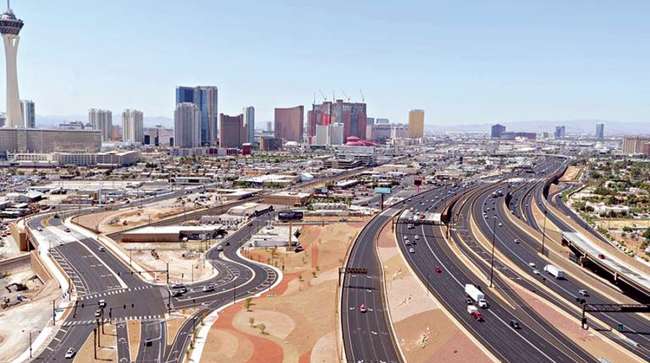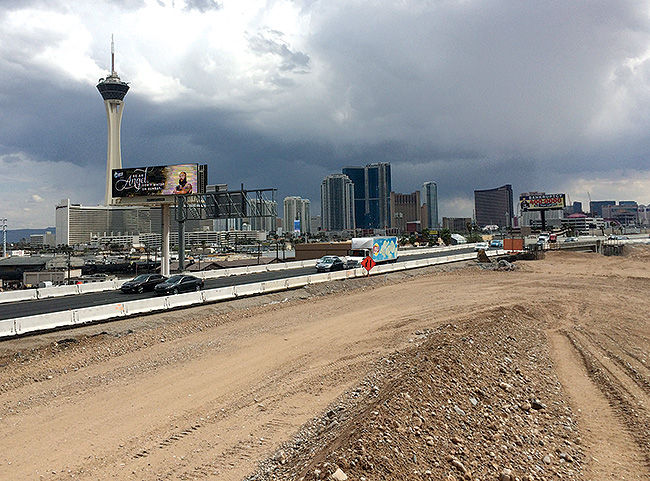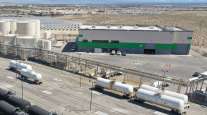Staff Reporter
Las Vegas’ $1 Billion Project Neon Ready for Spotlight

[Stay on top of transportation news: Get TTNews in your inbox.]
Project Neon, the $1 billion upgrade to Interstate 15 in Las Vegas, is finished.
The widening and revamp of ramps along a 3.7-mile segment of I-15, between U.S. Route 95 and Sahara Avenue, was the largest public works effort in the history of Nevada.
Overall, 63 lane miles were paved, 29 bridges constructed and 10 miles of drainage improvements implemented, according to Nevada Department of Transportation.
9 days and counting until Project Neon's "Grand Finale" https://t.co/GA6YsaMPfR #DTLV #VegasTraffic #ProjectNeonLV @CityOfLasVegas @RTCSNV @ClarkCountyNV @DTLVAlliance @FSELV @ArtsDistrictLV @NHPSouthernComm @SmithCenterLV @LVMPD @lvchamber @LVCVA @ClarkCountyFD @LasVegasFD pic.twitter.com/X8qhkGP0vg — Project Neon (@NDOTProjectNeon) July 30, 2019
Sahara Avenue is about 2.5 miles north of the Las Vegas Strip. The interchange where I-15 and U.S. 95 meet, north of Sahara Avenue, is the busiest stretch of highway in Nevada with 300,000 vehicles per day and 25,000 lane changes per hour. But NDOT did not have a breakdown of trucks and commercial vehicles for the segment, which is a freight corridor.
Cara Clarke, spokeswoman for the Las Vegas Metro Chamber of Commerce, said the new “ramp braids,” which are meant to facilitate merges onto the interstate, have helped with entrance and egress.
“It’s been a tremendous improvement on moving traffic flows through the center core of our community,” Clarke said. “It’s the major freight route going through our communities. It’s also a big tourism route, as well as just the day-to-day business traffic.”

Nevada Department of Transportation
Also in Nevada
Besides reducing congestion and facilitating vehicle movement, the goal of Project Neon is to improve air quality by creating less idle time and vehicle exhaust. The project is expected to reduce travel delays by 28%, which will yield $110 million in annual savings through increased productivity.
Clarke said one of the project’s controversial aspects is its conversion of express lanes along I-15 to high-occupancy vehicle lanes. She expressed doubt over the effectiveness of these lanes, which are ideal for car pool users as many people drive to work in Las Vegas.
David Brower, vice president of risk management at the Las Vegas-based trucking company Truline Corp., agreed, saying truckers can’t use HOV lanes as they used the express lanes.
“The result is that truck drivers become more involved with the regular traffic flow,” Brower said.

Project Neon construction in spring 2018. (Eugene Mulero/Transport Topics)
Brower was relieved that the three-year construction period has ended and said he appreciates the smoother roads and reduced congestion.
“You can kind of speculate that it was a project that should’ve been done before. Maybe they’re at a point now where it kind of matches the volume of traffic that flows through there,” Brower said.
The upgraded I-15 is meant to better accommodate freight movers, tourists (more than 42 million visited in 2018, according to the Las Vegas Convention and Visitors Authority) and a growing population. The Census Bureau reported Las Vegas’ population topped 644,000 in 2018.
NDOT spokesman Tony Illia said traffic through the I-15 corridor in Las Vegas is anticipated to nearly double during the next two decades. Clarke said the improvements offer much-needed capacity for the future.
“I think it was more of a catch-up than anything else,” Clarke said. “Now we have infrastructure that really is more aligned with our capacity and future capacity.”


